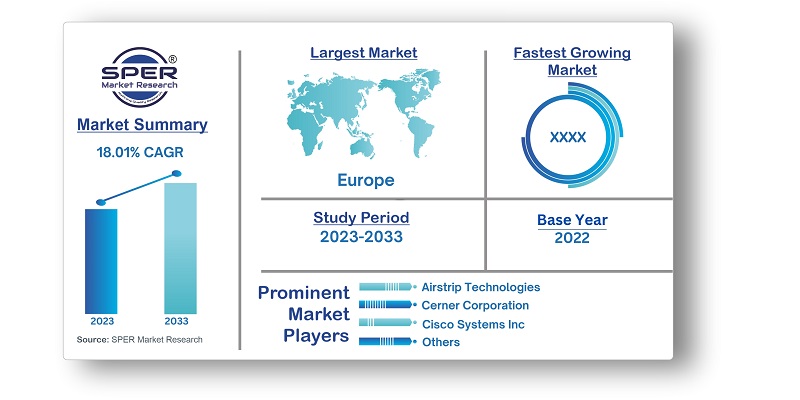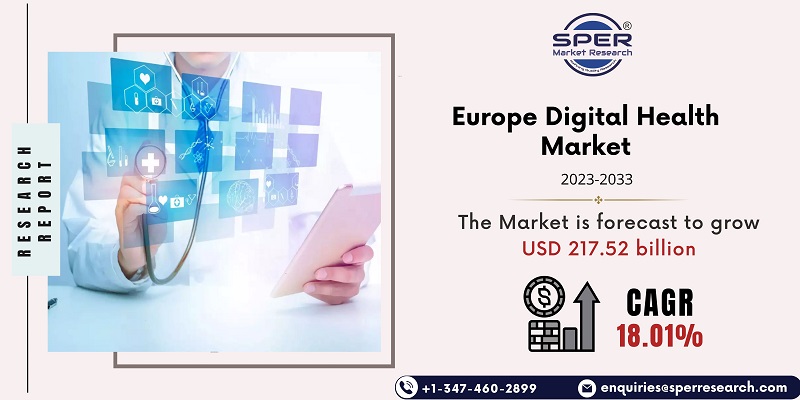
Europe Digital Health Market Growth, Size, Trends, Demand, Revenue, Share and Future Outlook
Europe Digital Health Market Size- By Component, By Technology- Regional Outlook, Competitive Strategies and Segment Forecast to 2033
| Published: Dec-2023 | Report ID: HLCA2382 | Pages: 1 - 153 | Formats*: |
| Category : Healthcare | |||
- In April 2023: A cutting-edge technical solution with predictive capabilities was introduced by Telefónica Tech and 3M to enhance patient satisfaction by managing the Hospital Emergency Department (HED) more effectively. Healthcare practitioners can use this solution to identify areas for development so they can make better decisions.
- In June 2023: Apple revealed new health features for watchOS 10, iPadOS 17, and iOS 17 in an effort to give consumers cutting-edge resources and encourage them to take responsibility for their health. Users can now access data to better understand their health thanks to the two new features related to mental health and vision health.


| Report Metric | Details |
| Market size available for years | 2019-2033 |
| Base year considered | 2022 |
| Forecast period | 2023-2033 |
| Segments covered | By Component, By Technology |
| Regions covered | U.K., Germany, France, Italy, Spain, Russia and rest of Europe |
| Companies Covered | Airstrip Technologies, Apple, Inc., Cerner Corporation, Cisco Systems Inc., Computer Programs and Systems, Inc., Epic Systems Corporation, Google, Inc., IBM Corporation, McKesson Corporation, Samsung Electronics Co. Ltd, Vodafone Group, Others |
- Health IT Companies
- Hospitals and Clinics
- Medical Device Manufacturers
- Nurses and Allied Health Professionals
- Patients and Caregivers
- Pharmaceutical Companies
- Physicians and Healthcare Practitioners
- Technology Companies
- Telehealth and Telemedicine Platforms
- Others
| By Component: |
|
| By Technology: |
|
| By Region: |
|
- Europe Digital Health Market Size (FY’2023-FY’2033)
- Overview of Europe Digital Health Market
- Segmentation of Europe Digital Health Market By Component (Hardware, Services, Software)
- Segmentation of Europe Digital Health Market By Technology (Digital Health Systems, Healthcare Analytics, mHealth, Tele-healthcare)
- Statistical Snap of Europe Digital Health Market
- Expansion Analysis of Europe Digital Health Market
- Problems and Obstacles in Europe Digital Health Market
- Competitive Landscape in the Europe Digital Health Market
- Impact of COVID-19 and Demonetization on Europe Digital Health Market
- Details on Current Investment in Europe Digital Health Market
- Competitive Analysis of Europe Digital Health Market
- Prominent Players in the Europe Digital Health Market
- SWOT Analysis of Europe Digital Health Market
- Europe Digital Health Market Future Outlook and Projections (FY’2023-FY’2033)
- Recommendations from Analyst
1.1. Scope of the report1.2. Market segment analysis
2.1. Research data source2.1.1. Secondary Data2.1.2. Primary Data2.1.3. SPER’s internal database2.1.4. Premium insight from KOL’s2.2. Market size estimation2.2.1. Top-down and Bottom-up approach2.3. Data triangulation
4.1. Driver, Restraint, Opportunity and Challenges analysis4.1.1. Drivers4.1.2. Restraints4.1.3. Opportunities4.1.4. Challenges4.2. COVID-19 Impacts of the Europe Digital Health Market
5.1. SWOT Analysis5.1.1. Strengths5.1.2. Weaknesses5.1.3. Opportunities5.1.4. Threats5.2. PESTEL Analysis5.2.1. Political Landscape5.2.2. Economic Landscape5.2.3. Social Landscape5.2.4. Technological Landscape5.2.5. Environmental Landscape5.2.6. Legal Landscape5.3. PORTER’s Five Forces5.3.1. Bargaining power of suppliers5.3.2. Bargaining power of buyers5.3.3. Threat of Substitute5.3.4. Threat of new entrant5.3.5. Competitive rivalry5.4. Heat Map Analysis
6.1. Europe Digital Health Market Manufacturing Base Distribution, Sales Area, Product Type6.2. Mergers & Acquisitions, Partnerships, Product Launch, and Collaboration in Europe Digital Health Market
7.1. Europe Digital Health Market Value Share and Forecast, By Component, 2023-20337.2. Hardware7.3. Services7.4. Software
8.1. Europe Digital Health Market Value Share and Forecast, By Technology, 2023-20338.2. Digital Health Systems8.2.1. EHR8.2.2. E-Prescribing Systems8.3. Healthcare Analytics8.4. mHealth Apps8.4.1. Fitness Apps8.4.2. Medical Apps8.5. mHealth Wearables8.5.1. Activity Trackers/ Actigraphs8.5.2. BP Monitors8.5.3. Glucose Meters8.5.4. Neurological Monitors8.5.5. Pulse Oximeters8.5.6. Sleep Apnea Monitors8.6. Tele-healthcare8.6.1. Tele-care8.6.2. Activity Monitoring8.6.3. Remote Medication Management8.6.4. Telehealth8.6.5. LTC Monitoring8.6.6. Video Consultation
9.1. Europe Digital Health Market Size and Market Share
10.1. Europe Digital Health Market Size and Market Share By Component (2019-2026)10.2. Europe Digital Health Market Size and Market Share By Component (2027-2033)
11.1. Europe Digital Health Market Size and Market Share By Technology (2019-2026)11.2. Europe Digital Health Market Size and Market Share By Technology (2027-2033)
12.1. Europe Digital Health Market Size and Market Share By Region (2019-2026)12.2. Europe Digital Health Market Size and Market Share By Region (2027-2033)12.3. U.K.12.4. Germany12.5. France12.6. Italy12.7. Spain12.8. Russia12.9. Rest of Europe
13.1. Airstrip Technologies13.1.1. Company details13.1.2. Financial outlook13.1.3. Product summary13.1.4. Recent developments13.2. Apple, Inc.13.2.1. Company details13.2.2. Financial outlook13.2.3. Product summary13.2.4. Recent developments13.3. Cerner Corporation13.3.1. Company details13.3.2. Financial outlook13.3.3. Product summary13.3.4. Recent developments13.4. Cisco Systems Inc.13.4.1. Company details13.4.2. Financial outlook13.4.3. Product summary13.4.4. Recent developments13.5. Computer Programs and Systems, Inc.13.5.1. Company details13.5.2. Financial outlook13.5.3. Product summary13.5.4. Recent developments13.6. Epic Systems Corporation13.6.1. Company details13.6.2. Financial outlook13.6.3. Product summary13.6.4. Recent developments13.7. Google, Inc.13.7.1. Company details13.7.2. Financial outlook13.7.3. Product summary13.7.4. Recent developments13.8. IBM Corporation13.8.1. Company details13.8.2. Financial outlook13.8.3. Product summary13.8.4. Recent developments13.9. McKesson Corporation13.9.1. Company details13.9.2. Financial outlook13.9.3. Product summary13.9.4. Recent developments13.10. Samsung Electronics Co. Ltd13.10.1. Company details13.10.2. Financial outlook13.10.3. Product summary13.10.4. Recent developments13.11. Vodafone Group13.11.1. Company details13.11.2. Financial outlook13.11.3. Product summary13.11.4. Recent developments13.12. Others
SPER Market Research’s methodology uses great emphasis on primary research to ensure that the market intelligence insights are up to date, reliable and accurate. Primary interviews are done with players involved in each phase of a supply chain to analyze the market forecasting. The secondary research method is used to help you fully understand how the future markets and the spending patterns look likes.
The report is based on in-depth qualitative and quantitative analysis of the Product Market. The quantitative analysis involves the application of various projection and sampling techniques. The qualitative analysis involves primary interviews, surveys, and vendor briefings. The data gathered as a result of these processes are validated through experts opinion. Our research methodology entails an ideal mixture of primary and secondary initiatives.



Frequently Asked Questions About This Report
PLACE AN ORDER
Year End Discount
Sample Report
Pre-Purchase Inquiry
NEED CUSTOMIZATION?
Request CustomizationCALL OR EMAIL US
100% Secure Payment






Related Reports
Our Global Clients
Our data-driven insights have influenced the strategy of 200+ reputed companies across the globe.




















